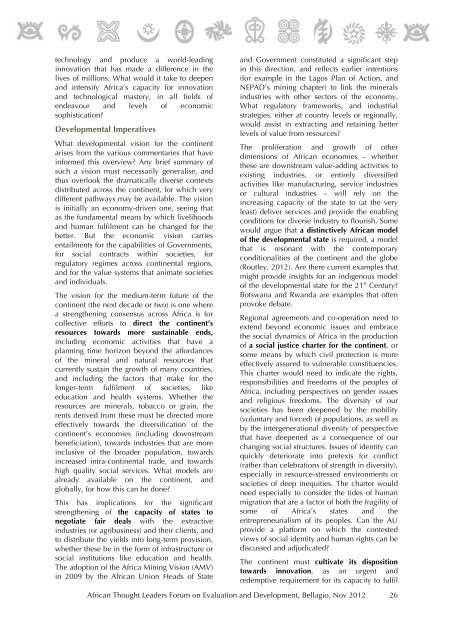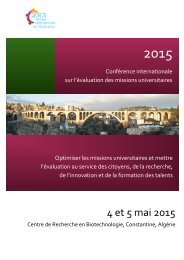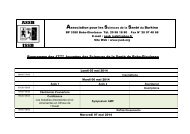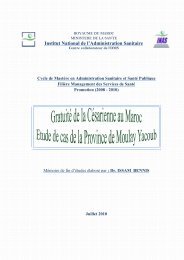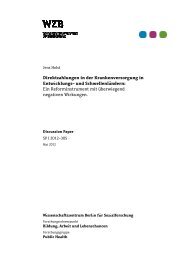Bellagio-Report-Vs-Apr-14
Bellagio-Report-Vs-Apr-14
Bellagio-Report-Vs-Apr-14
You also want an ePaper? Increase the reach of your titles
YUMPU automatically turns print PDFs into web optimized ePapers that Google loves.
technology and produce a world-leadinginnovation that has made a difference in thelives of millions. What would it take to deepenand intensify Africa’s capacity for innovationand technological mastery, in all fields ofendeavour and levels of economicsophistication?Developmental ImperativesWhat developmental vision for the continentarises from the various commentaries that haveinformed this overview? Any brief summary ofsuch a vision must necessarily generalise, andthus overlook the dramatically diverse contextsdistributed across the continent, for which verydifferent pathways may be available. The visionis initially an economy-driven one, seeing thatas the fundamental means by which livelihoodsand human fulfilment can be changed for thebetter. But the economic vision carriesentailments for the capabilities of Governments,for social contracts within societies, forregulatory regimes across continental regions,and for the value systems that animate societiesand individuals.The vision for the medium-term future of thecontinent (the next decade or two) is one wherea strengthening consensus across Africa is forcollective efforts to direct the continent’sresources towards more sustainable ends,including economic activities that have aplanning time horizon beyond the affordancesof the mineral and natural resources thatcurrently sustain the growth of many countries,and including the factors that make for thelonger-term fulfilment of societies, likeeducation and health systems. Whether theresources are minerals, tobacco or grain, therents derived from these must be directed moreeffectively towards the diversification of thecontinent’s economies (including downstreambeneficiation), towards industries that are moreinclusive of the broader population, towardsincreased intra-continental trade, and towardshigh quality social services. What models arealready available on the continent, andglobally, for how this can be done?This has implications for the significantstrengthening of the capacity of states tonegotiate fair deals with the extractiveindustries (or agribusiness) and their clients, andto distribute the yields into long-term provision,whether these be in the form of infrastructure orsocial institutions like education and health.The adoption of the Africa Mining Vision (AMV)in 2009 by the African Union Heads of Stateand Government constituted a significant stepin this direction, and reflects earlier intentions(for example in the Lagos Plan of Action, andNEPAD’s mining chapter) to link the mineralsindustries with other sectors of the economy.What regulatory frameworks, and industrialstrategies, either at country levels or regionally,would assist in extracting and retaining betterlevels of value from resources?The proliferation and growth of otherdimensions of African economies – whetherthese are downstream value-adding activities toexisting industries, or entirely diversifiedactivities like manufacturing, service industriesor cultural industries – will rely on theincreasing capacity of the state to (at the veryleast) deliver services and provide the enablingconditions for diverse industry to flourish. Somewould argue that a distinctively African modelof the developmental state is required, a modelthat is resonant with the contemporaryconditionalities of the continent and the globe(Routley, 2012). Are there current examples thatmight provide insights for an indigenous modelof the developmental state for the 21 st Century?Botswana and Rwanda are examples that oftenprovoke debate.Regional agreements and co-operation need toextend beyond economic issues and embracethe social dynamics of Africa in the productionof a social justice charter for the continent, orsome means by which civil protection is moreeffectively assured to vulnerable constituencies.This charter would need to indicate the rights,responsibilities and freedoms of the peoples ofAfrica, including perspectives on gender issuesand religious freedoms. The diversity of oursocieties has been deepened by the mobility(voluntary and forced) of populations, as well asby the intergenerational diversity of perspectivethat have deepened as a consequence of ourchanging social structures. Issues of identity canquickly deteriorate into pretexts for conflict(rather than celebrations of strength in diversity),especially in resource-stressed environments orsocieties of deep inequities. The charter wouldneed especially to consider the tides of humanmigration that are a factor of both the fragility ofsome of Africa’s states and theentrepreneurialism of its peoples. Can the AUprovide a platform on which the contestedviews of social identity and human rights can bediscussed and adjudicated?The continent must cultivate its dispositiontowards innovation, as an urgent andredemptive requirement for its capacity to fulfilAfrican Thought Leaders Forum on Evaluation and Development, <strong>Bellagio</strong>, Nov 2012 26


